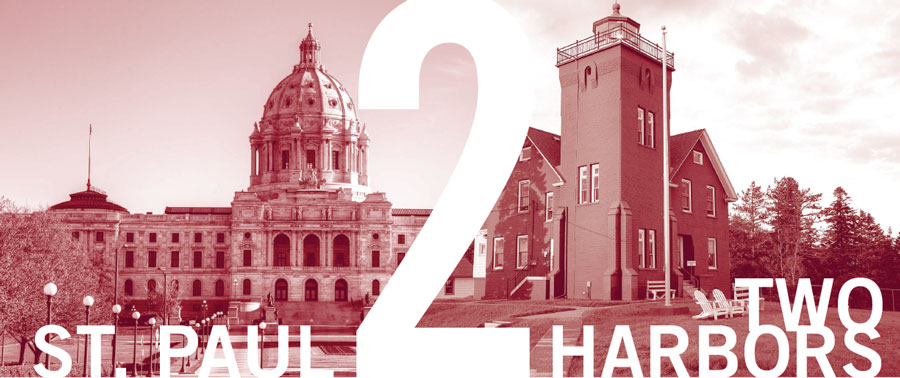As a young man growing up on Minnesota’s far western prairies during the 1960s, Allan Torstenson ’75 felt the lure of big cities tugging at him when he was deciding where to go to college.
He considered leaving his hometown of Dawson, Minn., for campuses on the coasts in Berkeley, Calif., or New York City, but it was the beehive of activity in Minneapolis and near the Augsburg College campus that drew him in.
“I was watching the anti-war movement unfold on television. People in a counter culture were fighting construction of HUD-planned communities, including Cedar Square West,” he said. “It was all happening on the West Bank of Minneapolis. I wanted to be there to watch it.”
At the same time that Torstenson was responding to the pull of Augsburg and all that its location in the heart of Minneapolis offered students, Mark Johnson ’75 found himself similarly drawn to Augsburg from his hometown of Two Harbors, Minn., on the scenic north shores of Lake Superior.
When the two young men arrived at Augsburg, they began to explore life in the city. They were among the first to enroll in what was a brand new interdisciplinary major, metro urban studies.
This new program would prove to build a solid foundation for the careers of both men, equipping them to navigate constantly changing landscapes in their careers. Torstenson’s Augsburg College education provided the skills and knowledge to begin work as an intern in 1981 for the City of St. Paul— where he continues to work today as principal city planner with responsibility for planning and zoning.
Johnson’s education allowed him to successfully return to Two Harbors where he took a detour from city planning for more than 20 years to run the family business before becoming the city planner from 1999 until his retirement in 2001.
Industry changes reshape Minnesota cities
Two Harbors is the birthplace of Minnesota Mining and Manufacturing (3M) and was long shaped by the railroad and an ore shipping port. St. Paul is the state capital and has been home to breweries such as Hamm’s and Schmidt’s, manufacturing such as Whirlpool and the Ford Assembly Plant, and more.
When the dominant industries in the cities served by Torstenson and Johnson inevitably shifted over time, the two planners needed to interpret what those changes meant for their communities.
In Two Harbors, the changes meant an opportunity to reclaim what once were private railroad beds and begin converting rails to trails. It also meant the opportunity to create greater public access to the waterfront.
In St. Paul, Torstenson was faced with answering questions about how to respond to a changing economy that has resulted in the shuttering of multiple large businesses.
“Our big building and manufacturing companies—Ford in Highland Park, Whirlpool on the East Side, [and] the breweries are all gone,” Torstenson said. “Our challenge was to begin to address the economic, structural, and job training issues left in the wake of these closings.”
One of the problems faced by Torstenson is that the underpinnings of earlier city planning—as it was practiced in the United States after World War II—wasn’t flexible or resilient, two concepts now at the forefront of civic design.
From the 1950s through the early 1980s, city planning primarily relied upon a single-use approach that identified different areas—or zones—for different uses. Single-family housing was clustered in one area, and apartments and condominiums in another area. Businesses were situated somewhere else, and industrial areas were planned in yet another spot.
This type of planning, possible largely because of the automobile, created what we now understand to be an expensive form of spread-out development often called “sprawl.” This type of segregated development can make responding to changing markets and demands difficult.
“Cities need to think about the social and market needs of the people who live there,” Torstenson said. “Cities also need to be resilient in their design so that they can be sustainable while evolving to meet changing needs.”
The more compact, high-density design used in Oslo, Norway, after World War II (and studied by both Torstenson and Johnson during their undergraduate study-abroad trip to Scandinavia in 1973) now is shaping the work Torstenson does for St. Paul. Multi-use design allows buildings to be placed closer together and to be used in multiple ways all at once. Business and light industry can be placed at street level with housing above. It means residents of a building have a greater likelihood of being able to walk to work and shop close to home. In addition, these environments typically include sidewalks, bike lanes, and public transit—whether in the form of light rail, trains, or streetcars.
“Many people want to live and work in a close, compact area,” Torstenson said. “Mixed-use and shared-use planning can create ways for us to change to meet the demands of a new and creative, diverse, and collaborative economy.” Today, Torstenson continues to work to shape a city code that will guide higher-density development and redevelopment that also fosters efficient, flexible, and mixed-form uses with multi-modal transportation corridors—all things that are sought-after by the Millennial Generation as well as today’s teenagers who are putting off learning to drive in favor of public transit.
While Torstenson was working in St. Paul, Johnson was grappling in Two Harbors with a community that at first didn’t have a history of proactive engagement, which meant that change had the potential to be seen as negative and foster greater outcry.
“The question always has been: How can we manage change for the good of all?” Johnson said. “There are always unintended consequences of change. At the core, we have to respect the values of the community we work with, and we have to reflect those qualities in the work.”
For instance, when Two Harbors in the 1990s began the work of creating greater public access to the waterfront by converting old railroad beds to trails, the community wasn’t happy.
“It seems that, in a smaller community, there can be a lot of pushback on any type of change,” Johnson said. “North Shore people are tough, independent. It’s just innate. We’ve spent our lives battling Lake Superior.”
But civic engagement is one tool that local governments such as cities and counties, no matter their location, can use to help learn about and understand the desires of a community.
“Community involvement is important,” Johnson said. “My job was a chance to encourage people to reach out beyond themselves and to seek ways to be a bridge builder of relationships.”
Although Johnson retired from city work more than a decade ago, he remains involved in Two Harbors through a community fund that he helped establish and that is used to support new projects in response to emerging and changing needs.
Johnson said that his days as an Augsburg student continue to influence him today and have played a role in creating a rewarding path for someone who has been driven to serve.
“I never saw my work at the family business or as city planner as separate paths,” he said. “My work as an employer, as a city planner, and as someone with an interest in community service gave me ways to make Two Harbors a better place.”
Community-classroom connection makes real-world impact
Community engagement is an essential part of city planning, but how that takes shape beyond town hall meetings and open forums varies.
City planners meet with community members, government entities, and local and federal agencies to gather perspective, priorities, and input from groups before projects are undertaken. But getting community participation that represents the diversity of viewpoints and priorities of any community is challenging.
The Friendly Streets Initiative in St. Paul is an emerging model of community engagement that aims to identify the shared needs and wants of people directly impacted by proposed change.
It’s a model being forged by Lars Christiansen, lead organizer of FSI and associate professor of Augsburg’s interdisciplinary metro-urban studies program. Christiansen, who also is chair of the Augsburg College Sociology Department, is known for his teaching and scholarship focused on urban resilience and sustainability, and public engagement.
Because of this community-classroom connection, metro-urban studies majors such as Darius Gray ’15 have augmented classroom experiences with hands-on learning.
“We engage [people] to give input on how they want their street to be designed,” said Gray, who has worked as an FSI intern for the past three years. “Basically we throw block parties and ask questions like: What if this was on your street? How would you feel?”
FSI staff facilitates community organizing, gathers and examines information, and helps citizens understand how local government operates.
“The model of engagement used by the Friendly Streets Initiative invites in those who feel left out of planning processes or who believe their input is sought for projects that are already a fait accompli,” Christiansen said in his article, “The Friendly Streets Initiative: Bringing Community Voices into the Planning Process.”
Christiansen writes that this groundbreaking work has unearthed lessons for successful community engagement, including bringing multiple voices into the mix before formal planning is underway; creating community engagement events that are fun, family-friendly, and easy to access; helping neighbors navigate formal city processes; and using multiple methods to garner input.
Through their work in the classroom and out in the community, a new generation of Augsburg College students is prepared to leave its mark on American cities and to steward the world’s resources well into the future.
Learn more about the Friendly Streets Initiative and model used at friendlystreetsinitiative.org.





